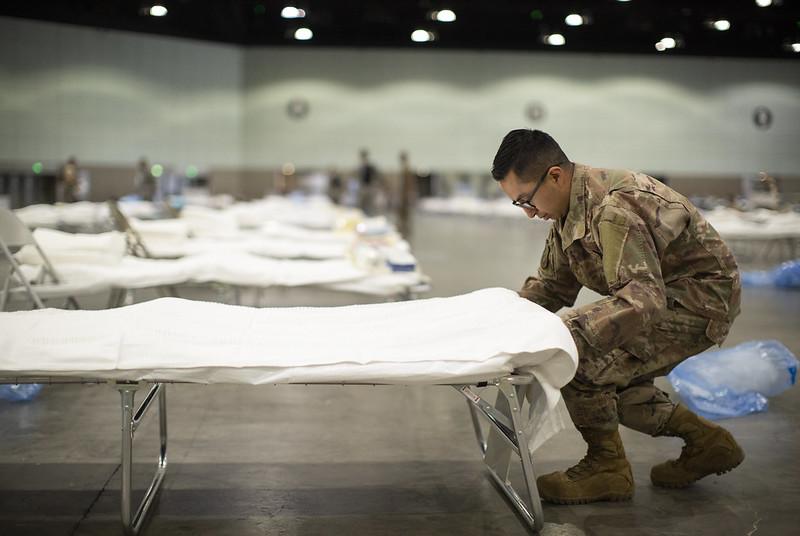
US President Donald Trump has labelled himself a wartime president, and many other leaders around the world are using similar language. It’s a description that raises an obvious question: what do the history and nature of war tell us about fighting a virus?
While war should normally be a policy of last resort, not confronting an enemy that is determined to attack and poses an imminent threat can be deadly. Indeed, the enemy morphed from a local outbreak in Wuhan into a global pandemic precisely because the Chinese authorities squandered precious weeks before confronting it. China’s leadership initially covered up the outbreak and allowed millions of people to leave Wuhan even though many carried the virus with them.
The United States also manifested a widespread initial reluctance to go to war. This comes as little surprise. War as a last resort is one of the tenets of the ‘just war’ theory, the body of thinking that emerged in the Middle Ages and was intended to make wars less common and less violent.
The problem, though, is that it takes two to avoid conflict, and the virus was determined to bring it on. Putting off the decision to go on the offensive against Covid-19—treating a war of necessity as a war of choice—has proved extraordinarily costly in terms of lives lost and economic destruction.
Once leaders recognised that war was necessary, they soon realised they had no weapons. A vaccine is an estimated 12–18 months off. Antiviral drugs could be available sooner, but they, too, won’t come soon. As former US defence secretary Donald Rumsfeld put it, ‘You go to war with the army you have, not the army you might want or wish to have at a later time.’ This is a war that must be fought for the foreseeable future in ways designed to frustrate the enemy rather than defeat it.
The best tactic available now is dispersion, to offer the enemy fewer targets. Relatively weak militaries often employ this method by avoiding set-piece battles against stronger forces. Dispersion, in today’s parlance, means social distancing.
The problem is that social distancing was postponed in many countries or is being applied unevenly. It’s often said that speed kills; when it comes to heading off or limiting pandemics, it’s delay that kills. The countries that have fared best against the coronavirus so far, like South Korea and Singapore, acted quickly and decisively.
This war is also being waged with a lack of defensive equipment. One of the most important tasks is to identify those who have been infected and trace their contacts. Both groups need to be isolated quickly. This is the only way to understand the threat, to break through what the Prussian military strategist Carl von Clausewitz is credited with calling the ‘fog of war’.
But the testing needed to identify those who are infected is simply not of sufficient quality or available in sufficient quantity in most countries. Closing borders can be helpful (particularly early on, before the virus becomes widespread in a society), but it is no panacea. Similarly, mass testing to reveal who has developed immunity to the virus, which is essential for people to be able to gather safely, whether for work or play, is not yet available.
The strategy must be to play for time until we are equipped to attack Covid-19 with antiviral drugs or, better yet, a vaccine. Dispersion and testing are needed to accomplish this.
The last question is when to end the war. Trump and many of his counterparts around the globe are understandably in a hurry to restart their economies. We and they must have the discipline not to rush. We need to fight a holding action on the economic front by providing relief to workers and businesses, until the war on the virus is mostly won and recovery can begin in earnest. Terminating the war too soon will only extend its duration and increase its cost.
Much of the world entered this war in a condition close to unilateral disarmament. That can never happen again. Countries must maintain stockpiles of protective gear and medical equipment, increase resources devoted to ‘peacetime’ research and development of relevant therapies, and rehearse responses to a pandemic at all levels of government. Too many doctors, nurses, first-responders, police and fire personnel—those working on the front lines—are being sent into battle without armour. And too many casualties lack access to the medical care all of us need them to have.
Countries also need to embrace joint action. Just as one builds coalitions to fight conventional wars, allies are needed to fight pandemics. We will need to enlist others to respect rules and meet standards when it comes to reporting, fighting and containing infectious disease outbreaks. And richer countries will need to come together to strengthen poorer countries’ public health capacities, not just for humanitarian reasons, but also out of self-interest. We are only as strong as the weakest among us.
This war should not have surprised us. It was predictable and it was predicted. Pandemics are not black swans; they are baked into the cake of globalisation. And they can start anywhere. This time it was Wuhan. Next time it could be Wichita.
And there will be a next time, if not Covid-20, then perhaps Covid-21 or some other pathogen. Borders and sovereignty can be breached; little stays local for long. The challenge is to be ready so that an outbreak does not become a pandemic, and a pandemic does not become a catastrophe.